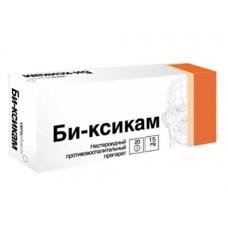Expiration date: 06/2026
The composition and form of issue:
Tablets. 1 tablet contains:
meloxicam 7.5 or 15 mg
excipients: sodium citrate dihydrate, anhydrous lactose (milk sugar) MCC PVP 25000 silicon dioxide colloidal (Aerosil) polyplasdone X l 10 (crospovidone) magnesium stearate
in packing contour cell 10 PCs per cartons 2 packages.
Description pharmaceutical form:
Tablets light yellow in color, valium forms.
Pharmacokinetics:
Well absorbed from the gastrointestinal tract, the absolute bioavailability of meloxicam is 89%, not dependent on food intake. When using the drug orally in doses of 7, 5 and 15 mg, its concentration in plasma is dose-dependent. Equilibrium concentration achieved within 3-5 days. Long-term use of the drug (more than 1 year), concentrations similar to those observed after the first achievement of steady state pharmacokinetics. The plasma protein binding is 99%. The range of differences between the maximum and basal concentrations of the drug after taking it once a day and is relatively small when using doses of 7, 5 mg 0, 4-1, 0 µg/ml, and when using doses of 15 mg — 0, 8-2, 0 mcg/ml (shown, respectively, values of Cmin and Cmax). Meloxicam permeates through gistogematicalkie barriers, concentration in synovial fluid reaches the 50% of the Cmax of the drug in plasma.
Almost completely metabolized in the liver with involvement of CYP 2C9, CYP 3A4 and peroxidases with the formation of four inactive derivatives.
Excreted equally in feces and urine, primarily as metabolites. Faeces in unaltered form appears less 5% the magnitude of the daily dose, in the urine in an unmodified form the drug is detected only in trace amounts. T1/2 meloxicam is 15-20 hrs, Plasma clearance averages 8 ml/min in the elderly, clearance of the drug is reduced. The volume of distribution is low and averages 11 l
Hepatic or renal insufficiency medium severity significant effect on the pharmacokinetics of meloxicam has not.
Description of the pharmacological action:
Meloxicam is an NSAID that has analgesic, anti-inflammatory and antipyretic activity. Mechanism of action — selective inhibition of the enzymatic activity of COX-2, involved in the biosynthesis of PG in the field of inflammation. When administered in high doses, prolonged use and individual characteristics of the organism selectivity may be reduced. Inhibits synthesis of PG in the field of inflammation to a greater extent than in the mucous membrane of the gastrointestinal tract and the kidneys.
Indications:
Inflammatory and degenerative diseases of the joints, accompanied by pain syndrome:
- rheumatoid arthritis
- osteoarthrosis
- ankylosing spondylitis (Bechterew's disease).
Contraindications:
- hypersensitivity to any component of the drug
- aspirin bronchial asthma
- aggravation of gastric ulcer and duodenal ulcer
- gastrointestinal, cerebrovascular or other bleeding
- severe renal failure (unless hemodialysis is)
- severe liver failure
- severe heart failure
- pregnancy
- lactation
- children up to age 15 years.
With caution:
- elderly patients
- erosivno-azwenne defeat of the gastrointestinal tract in anamnesis.
Application of pregnancy and breastfeeding:
The drug is not recommended during pregnancy and lactation.
Side effect:
The digestive system: nausea, vomiting, abdominal pain, diarrhea, constipation, flatulence, erosivno-azwenne shock syndrome, perforation of the stomach or intestines, gastrointestinal bleeding (implicit or explicit), increased liver enzymes, hepatitis, colitis, stomatitis, dry mouth, esophagitis.
Cardiovascular system: tachycardia, the AD, feeling tide blood to a person.
Respiratory system: exacerbation of asthma, cough.
CNS: headache, dizziness, tinnitus, disorientation, confusion, sleep disturbance.
Urogenital system: swelling, interstitial nephritis, renal medullary necrosis, urinary tract infection, proteinuria, hematuria, renal failure.
The organs of vision: conjunctivitis, blurred vision.
Skin: itching, skin rash, urticaria, exudative erythema multiforme (including Stevens-Johnson syndrome), toxic epidermal necrolysis (Lyell's syndrome), increased photosensitivity.
Hematopoietic system: anemia, leukopenia, thrombocytopenia.
Allergic reactions: anaphylactoid reaction (including anaphylactic shock), swelling of the lips and tongue, allergic vasculitis.
Other: fever.
Drug interaction:
While the use of other NSAIDs (including salicylates) may increase the risk of erosive and ulcerative lesions and bleeding from the alimentary tract with antihypertensive drugs, and intrauterine contraceptives — may reduce the effectiveness of their action with the drugs lithium may increase the level of lithium in the plasma (recommended monitoring of lithium concentration in the blood) with methotrexate — haematological increases the effect of the latter (shown by periodic monitoring of complete blood count) together with the use of diuretics and cyclosporine, the potential exists for the development of acute renal failure in patients with dehydration. The combination of anticoagulants and antiplatelet agents (heparin, tiklopidin, warfarin), and thrombolytic drugs (streptokinase, fibrinolysin) increases the risk of bleeding (a periodic monitoring of indicators of blood coagulation). Cholestyramine binds to meloxicam, as a result, increases its excretion through the gastrointestinal tract.
Method of application and doses:
Inside, during a meal, 1 time a day.
Rheumatoid arthritis is 15 mg/day. Depending on the therapeutic effect dose can be reduced to 7, 5 mg/day.
Osteoarthritis — 7, 5 mg/day. The ineffectiveness of the dose may be increased to 15 mg/day.
Ankylosing spondylitis 15 mg/day.
The maximum daily dose should not exceed 15 mg in patients with an increased risk of side effects the initial dose should not exceed 7, 5 mg/day.
Overdose:
Symptoms: increased side effects
Treatment: gastric lavage, the appointment activated charcoal (within the next hour after intake), symptomatic therapy. There is no specific antidote. Cholestyramine accelerates the elimination of the drug from the body.
Precautionary measures:
Caution must be exercised in applying the drug in patients with a history who have peptic ulcer of stomach and duodenum, and in patients on anticoagulation therapy. These patients are at increased risk of exacerbation of ulcerative and erosive diseases of the gastrointestinal tract.
Use caution and monitor indicators of kidney function if use of the drug in elderly patients, patients with chronic heart failure with symptoms of circulatory failure in patients with cirrhosis of the liver, as well as in patients with gipovolemiei as a result of surgical interventions.
In patients with renal failure, if creatinine clearance >25 ml/min, does not require correction of dosing regimen.
For patients on dialysis, the dosage should not exceed 7, 5 mg/day.
Patients simultaneously receiving diuretics and meloxicam, should take plenty of fluids.
If the treatment process had an allergic reaction (itching, skin rash, urticaria, photosensitivity), it is necessary to consult a doctor to address the issue of termination of treatment.
Special instruction:
The management of vehicles, maintenance of machines and mechanisms
The use of the drug may cause side effects such as headache and dizziness, drowsiness. In these cases, you should refuse to drive vehicles and maintenance of machinery and other activities requiring concentration.


